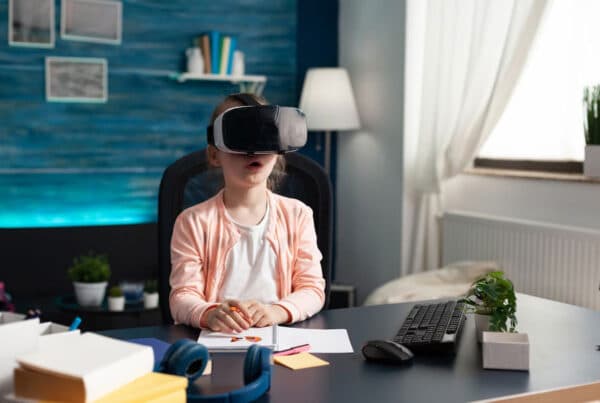
In today’s rapidly changing job market, workforce development and skill training have become increasingly critical. Employers are seeking innovative ways to prepare their workforce for the challenges of a modern economy, and virtual reality (VR) is emerging as a powerful tool in this endeavor. By providing immersive and interactive learning experiences, VR technology is transforming the landscape of workforce training, enabling employees to acquire new skills efficiently and effectively. This article explores the applications of virtual reality in workforce development and skill training, highlighting its benefits, challenges, and real-world examples.
Understanding Virtual Reality in Workforce Development
Virtual reality is a technology that creates a simulated environment, allowing users to engage with computer-generated content in a three-dimensional space. Users typically wear VR headsets that track their movements, enabling them to interact with virtual objects and scenarios as if they were real. This level of immersion makes VR an ideal medium for workforce training, as it can simulate complex tasks and scenarios without the associated risks or costs of real-world training.
Benefits of VR in Workforce Development
- Enhanced Engagement and Retention
Traditional training methods, such as lectures or e-learning modules, often fail to engage participants fully. VR, on the other hand, captivates users by immersing them in realistic environments that demand active participation. Studies show that immersive training experiences lead to higher retention rates compared to conventional training methods. When employees engage with VR simulations, they are more likely to remember what they learned, as the experiences are often more memorable than passive forms of learning. - Safe Learning Environment
VR provides a safe space for employees to practice skills without the risks associated with real-world scenarios. For example, in fields like healthcare, construction, and manufacturing, trainees can practice critical skills—such as performing surgeries, operating heavy machinery, or managing hazardous materials—without jeopardizing safety. This risk-free environment allows employees to learn from their mistakes and gain confidence before applying their skills in real-world situations. - Customization and Flexibility
Virtual reality training programs can be tailored to meet the specific needs of different industries and job roles. Organizations can create customized VR scenarios that replicate their unique work environments, procedures, and challenges. This flexibility ensures that employees receive relevant training that directly translates to their job functions. Additionally, VR training can be accessed remotely, allowing employees to learn at their own pace and convenience. - Cost-Effective Training Solutions
Although the initial investment in VR technology may be significant, the long-term cost savings can be substantial. By reducing the need for physical training materials, travel, and time spent in training sessions, organizations can save money while providing high-quality training. Moreover, VR allows for repeated practice without incurring additional costs, enabling employees to hone their skills until they achieve proficiency. - Scalability
VR training programs can be scaled to accommodate large numbers of employees simultaneously. Organizations can deploy VR training across multiple locations, ensuring that all employees receive consistent training experiences regardless of their geographic location. This scalability is particularly valuable for multinational companies with diverse workforces.
Real-World Applications of VR in Workforce Development
- Healthcare Training
In the healthcare industry, VR is being used to train medical professionals in various procedures and patient interactions. For example, organizations like Osso VR and Medical Realities offer VR simulations that allow surgeons to practice complex surgical techniques. These simulations enable surgeons to refine their skills and gain experience in a risk-free environment, ultimately leading to improved patient outcomes. - Manufacturing and Industry
Manufacturing companies are leveraging VR for training employees on operating machinery, assembly line processes, and safety protocols. Companies like Boeing have implemented VR training for assembly line workers, allowing them to visualize complex parts and understand assembly processes before working on the actual products. This training method reduces errors and increases efficiency on the production floor. - Construction and Safety Training
The construction industry has embraced VR as a tool for safety training and hazard recognition. Platforms like Immersive Labs offer VR simulations that expose workers to potential hazards they might encounter on construction sites. Trainees learn to identify risks and practice safety procedures in a controlled environment, ultimately reducing workplace accidents. - Retail and Customer Service
Retailers are utilizing VR to train employees in customer service and sales techniques. For example, Walmart has implemented VR training for its employees, enabling them to practice handling customer interactions and managing challenging situations. This immersive training helps employees build confidence and improve their customer service skills, leading to better shopping experiences for customers. - Corporate Training and Leadership Development
VR is also being used in corporate training programs to develop leadership skills and enhance team collaboration. Companies like STRIVR offer VR training solutions that simulate real-world business scenarios, allowing employees to practice decision-making, conflict resolution, and team dynamics. This experiential learning approach fosters a deeper understanding of leadership concepts and prepares employees for future management roles.
Challenges and Considerations
While the potential of VR in workforce development is significant, several challenges and considerations must be addressed:
- Initial Investment Costs
The cost of VR hardware and software can be a barrier for some organizations. While prices have been decreasing, smaller businesses may still find it challenging to invest in VR technology. Organizations must weigh the initial costs against the long-term benefits of implementing VR training programs. - Content Development
Creating high-quality VR training content requires specialized skills and expertise. Organizations may need to partner with VR development companies or invest in training their own staff to develop effective simulations. Ensuring that the content is relevant, engaging, and aligned with learning objectives is crucial for the success of VR training programs. - Technological Limitations
Despite advancements in VR technology, issues such as motion sickness and user fatigue can hinder the effectiveness of VR training. Developers must focus on creating comfortable and user-friendly experiences to minimize these concerns. Additionally, organizations should provide adequate support and training to help employees acclimate to using VR technology. - Measuring Effectiveness
Measuring the impact of VR training on employee performance can be challenging. Organizations need to establish clear metrics for success and conduct thorough evaluations to determine the effectiveness of VR training programs. Gathering feedback from participants and tracking performance improvements are essential for continuous improvement.
Conclusion
Virtual reality is revolutionizing workforce development and skill training by providing immersive, engaging, and effective learning experiences. From healthcare to manufacturing and corporate training, VR is being utilized across various industries to enhance employee skills and prepare them for the challenges of the modern workplace. While there are challenges to overcome, the benefits of VR in training are undeniable. As technology continues to advance and become more accessible, we can expect to see even greater integration of virtual reality into workforce development strategies, ultimately leading to a more skilled and capable workforce. By embracing VR, organizations can not only enhance their training programs but also empower their employees to thrive in an increasingly complex and competitive job market.
Empower your workforce with Virtual Reality Training! Contact Virtually Anywhere today to discover how VR enhances skill development, boosts engagement, and improves retention through immersive, hands-on experiences. From employee onboarding to advanced technical training, VR is revolutionizing workforce development. Start building a smarter, more skilled team today!




